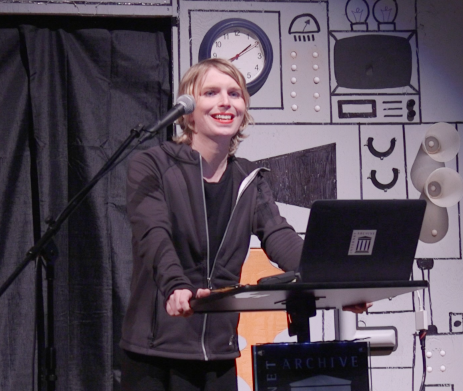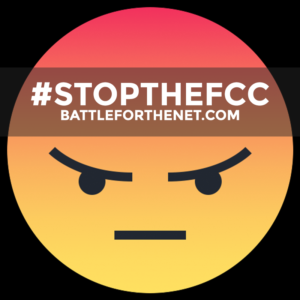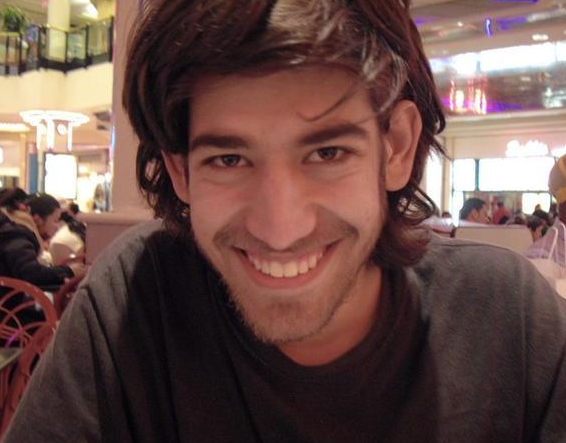“You don’t have to engage in direct action to support those who do.” – Chelsea E. Manning.
Well hello.
Here I am.
So, I see things have changed a little bit since last year. Since I was last out and about in the world.
First off, I’ve “spoken” – actually I’ve had two statements read at this event in the past (2015) (2016), and that’s a little different — I’m actually here.
I want to talk a little bit about where we are today. What we’re looking at and what we’re dealing with.
Because I’ve been out and about for a few months, I’ve obviously seen the sights and I see what’s going on. There’s a lot that’s changed. There’s Nazis and KKK running around. :-( (I don’t remember that being a big deal, whenever I was out.)
So, I think it’s really important to remember – especially at a time like this – that institutions – the institutions we depend on. Institutions that matter to us. Institutions that make decisions over us. Whether it’s a large corporation or a criminal justice system or media entities or whatever, like these large institutions can and they regularly do fail, and I think it’s important to recognize that sometimes institutions don’t work. And when they don’t work, you can’t ask them to work again. You know? You just can’t.
So, what we’re seeing today, I think, is more institutions that are depending on secrecy. More institutions that are depending on cracking down on any forms of dissent or disagreement or even just a hint of potential threat to them. And all of this is surrounded by this notion of power. Institutions have power. They have the ability to make decisions over our lives, and they’ve kind of rigged the systems.
The ways in which we engage in public. The ways in which we engage with our institutions – they are usually very administrative. Like you go to your ballot box and you have an election, or you have a procedure, or an administrative complaint, or a redress request, or something like that. And also, there’s a lot of compromise that happens between institutions and us. And a lot of us end up asking the question “well, you know, this really sucks” you know, “this isn’t working. Maybe somebody should do something about this?”
And I think that’s a really important moment that happens in each and every one of us. Is that moment where it’s like “this isn’t working, but what can I do?” I get asked a lot: “What can I do?” And, I think it’s really important to remember that whenever systems fail, and whenever institutions don’t work, you do have agency. You do have power. And every single person who’s spoken today introduces us to different ways in which we can engage with power and which we can actually have a forceable impact to have the political agency beyond what we see. Beyond the ballot box. There’s more to politics than just elections or court orders or requests or lawsuits. There’s so much more.
I look at the various forms of direct action as an answer to that process. Whether it’s…I engage in a form of direction but it’s different than another form. We all have different ways in which we can engage in political agency, and together as a collective group of people. We have power and we have the ability to make decisions, and we have the ability to make that be known, even whenever institutions ask us not to. Or tell us not to, forcefully.
I look at how each and every one of us has power. Once of the most inspiring moments I’ve seen since I’ve been out is when I watched as a group of people taking down a Confederate statue in Durham, North Carolina, and I found that inspiring. I found that powerful. I relate to that. I feel like that’s very similar. It feels empowering.
We don’t have to engage in direct action. We don’t all have to do these things. We can also support each other and we can support people who do the right thing or make a decision and end up in trouble or whether its facing getting fired or getting prosecuted or going to prison. We can provide support for people. You don’t have to engage in direct action to support those who do.
Prisoner support works. I was a prisoner for seven years. Lisa, she supported me when I was in prison. Lisa Rein. I’ve had many many many hours on the phone with Lisa, and she helped me in times when I was troubled. When I was alone. Whenever I was doubting myself. Whenever I felt I wasn’t being heard or whenever I felt I was being forgotten. And she was there. And she would sometimes pick up the phone in the supermarket. Or pick up the phone, ya know, while running. Or like, as she’s doing live things. So, she was there for me, and that support really mattered.
We can write letters. We can give inmates money for commissary or for legal defense. We can show our solidarity. We can show up to court hearings. We can write petitions. We can actively do things to help people that do place themselves at risk against their institutions. And it’s really important remind people that have been in positions like we have that we’re not forgotten cause it’s really easy to feel like we’re forgotten sometimes.
On a more positive note for the future though. I think it’s really important to remember that we live in a time where we don’t need leaders to tell us what to do, or to guide us in a time like this. I think we need each other. I lean upon people that are closest to me. I learned this in prison that the people closest to you are the people that matter the most. I looked to them when the prison staff was treating me awfully. Or, just as much as I could reach out to Lisa, I had my prison friends across the table from me. Or down the hall. Or in the cell two doors down that I could reach out to. We worked together. We can depend on each other. We needed each other.
That works out here as well. We need each other. We know what our communities need. Each one of us knows what our community needs. Someone that’s way up upon high that makes decisions doesn’t know what our community needs.
I also think it’s important to remember – especially because I’m told a lot: “You really give me hope.”
I don’t give anybody hope. Hope is not something that anyone can give to you. Nobody can give you hope. Hope is something that you already have. You just have to find it, and we have to help each other find it. Nobody gave me hope when I was in prison. I had to find it. I found it and it got me through. And the support helped me find it.
It’s really important to remember that we do have this. “We got this” – that’s a hashtag that I use very frequently on my Twitter, and it actually comes from a phrase that I said many many times to Lisa, whenever we were having troubled moments over the phone. Whenever she was helping me. Even whenever it looked like… Cause ya know, I didn’t think this would happen. I didn’t think I’d be standing here today. I really didn’t. We had moments when neither of us did. But, she worked so hard.
And and one of the things that we used to say was “We got this. We got this.” Even whenever it didn’t look like we did. And I think it’s real important to remember that sometimes, even whenever it looks like you don’t have it, you really do. And so we got this. Thank you Lisa. Thank you everyone. It’s very powerful for me to be here tonight.
 Congress’ latest bait and switch tactic regarding Net Neutrality is called the “Open Internet Preservation Act ,” which pretty much does the opposite that the title suggests.
Congress’ latest bait and switch tactic regarding Net Neutrality is called the “Open Internet Preservation Act ,” which pretty much does the opposite that the title suggests.

